Haskell is a pure functional programming language that was created in 1987 by a committee of researchers. It features lazy evaluation, pattern matching, list comprehensions, and type polymorphism. Haskell does not use variables or loops, instead relying on recursion. It has evolved over time from Haskell 1.0 to the current Haskell 2010 standard. For beginners, Hugs is a good starting point, while Haskell Platform is recommended for developers.
![Introduction
Sebastian Rettig
“Work on Haskell began in 1987 when aa committee of
“Work on Haskell began in 1987 when committee of
researchers got together to design aa kick-ass language.”([1])
researchers got together to design kick-ass language.” ([1])](https://image.slidesharecdn.com/haskellintro-120315205608-phpapp01/75/01-haskell-introduction-1-2048.jpg)
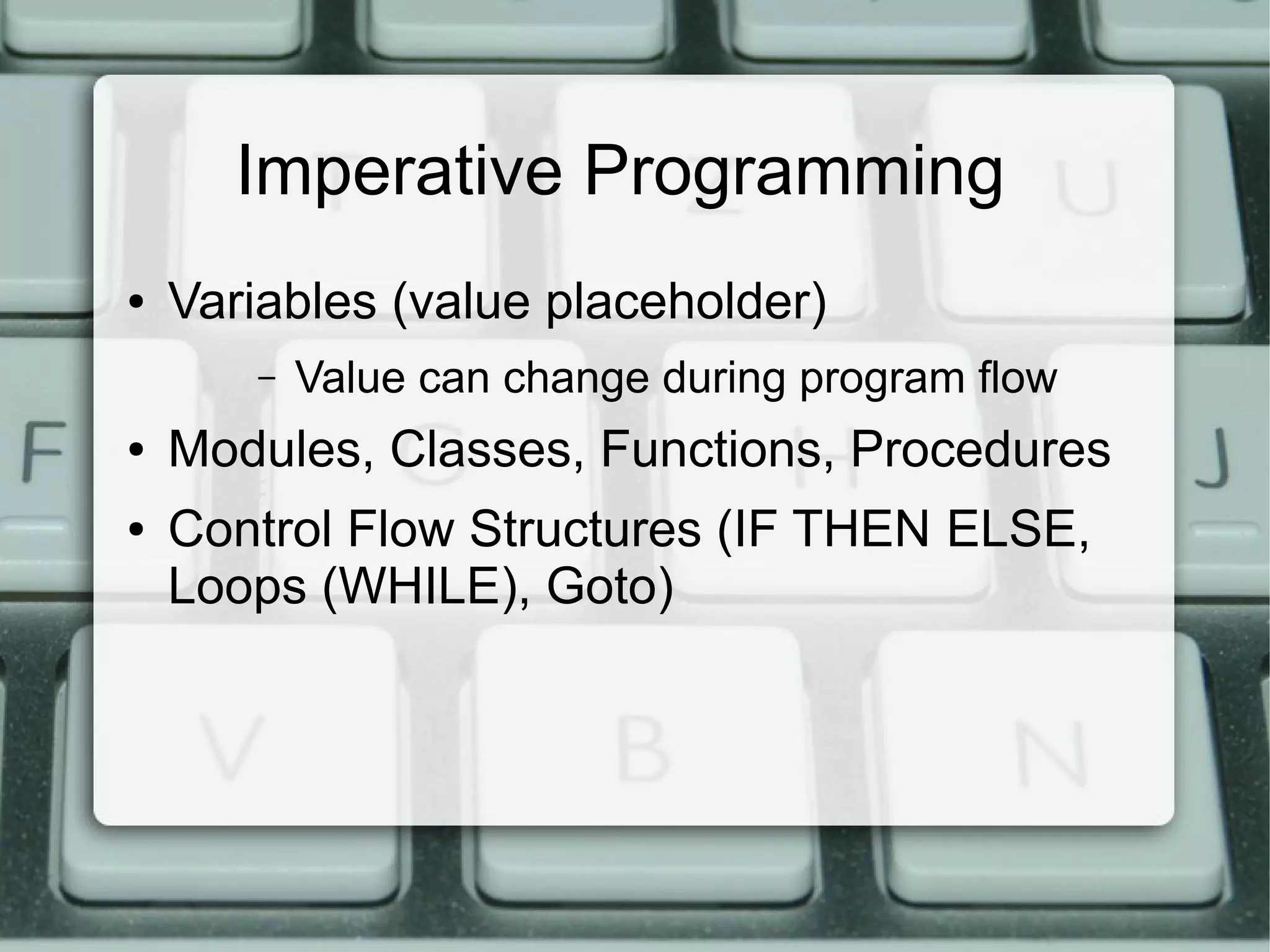
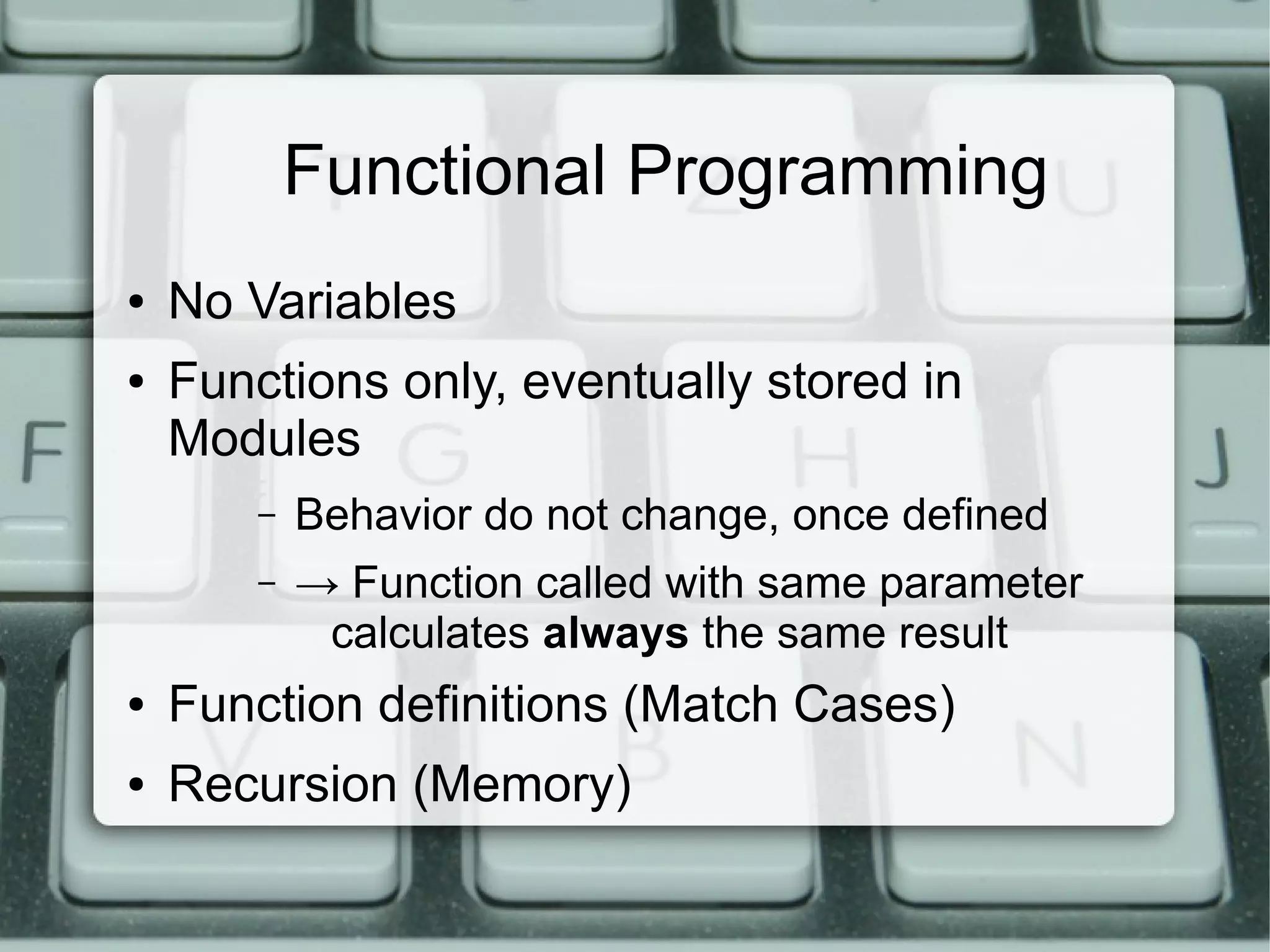
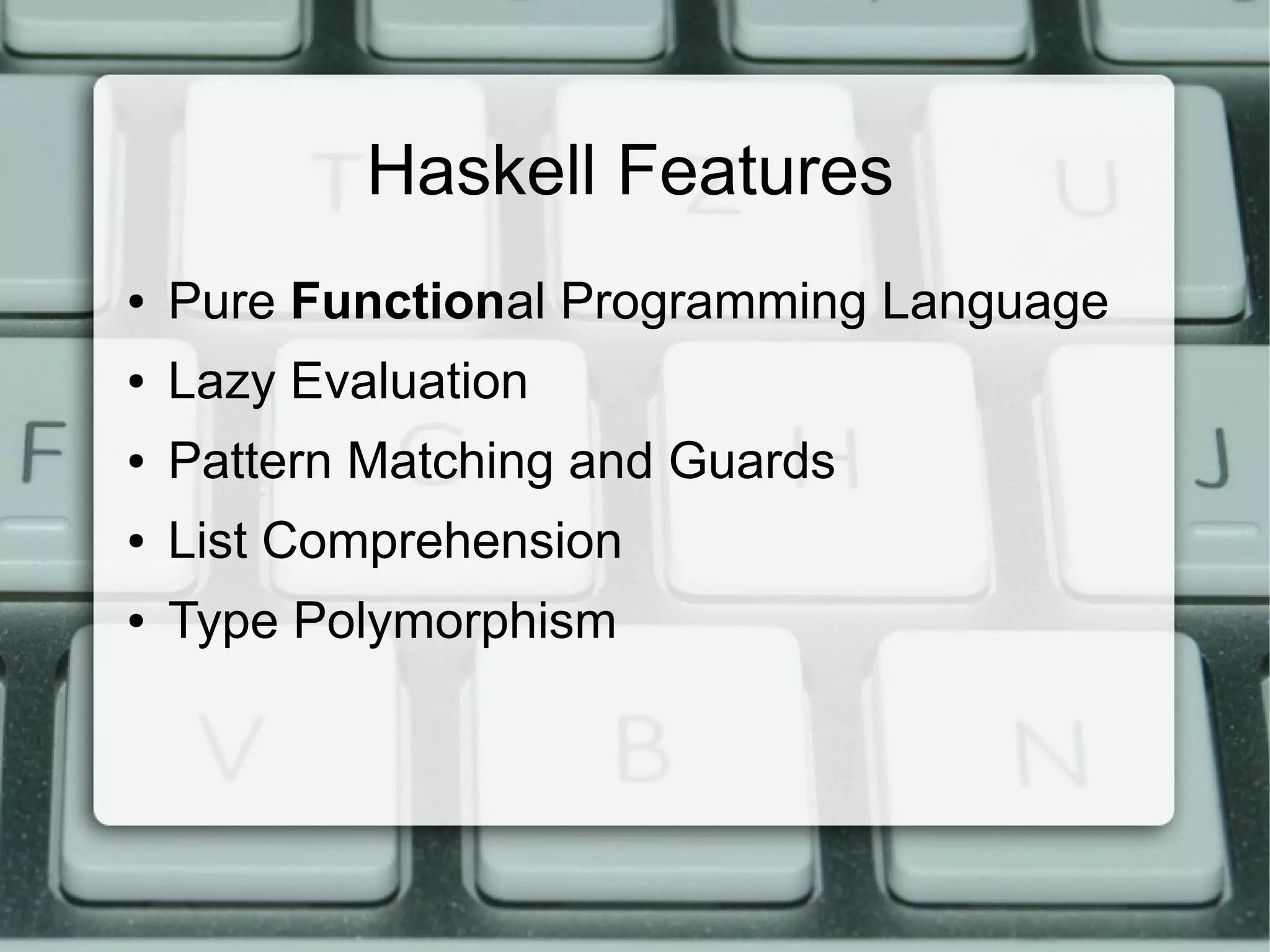
![Haskell Functions (1)
● function contains header and body
● header consists of type definition:
<funcname> :: <param> [ -> <param_n>] -> <result>
● body consists of pattern rules and calculation
<funcname> <paramalias_1> [<paramalias_n>] = {calc}
– more later...
● Example (2 params if type [Int] & Int, result Bool):
isHead :: [Int] -> Int -> Bool
isHead xs i = i==head xs](https://image.slidesharecdn.com/haskellintro-120315205608-phpapp01/75/01-haskell-introduction-5-2048.jpg)
![Haskell Functions (2)
● You want an Interface? No Problem
myMap :: (Float -> Int) -> [Int] -> [Int]
● first parameter of myMap is a function
● allows all functions, with Float parameter and result of
type Int
● interface also individual extendable
myMap :: (Float -> Bool -> Int) -> [Int] -> [Int]
● or include a sub-level interface
myMap :: ((Int -> Float) -> Bool -> Int) -> [Int] -> [Int]](https://image.slidesharecdn.com/haskellintro-120315205608-phpapp01/75/01-haskell-introduction-6-2048.jpg)
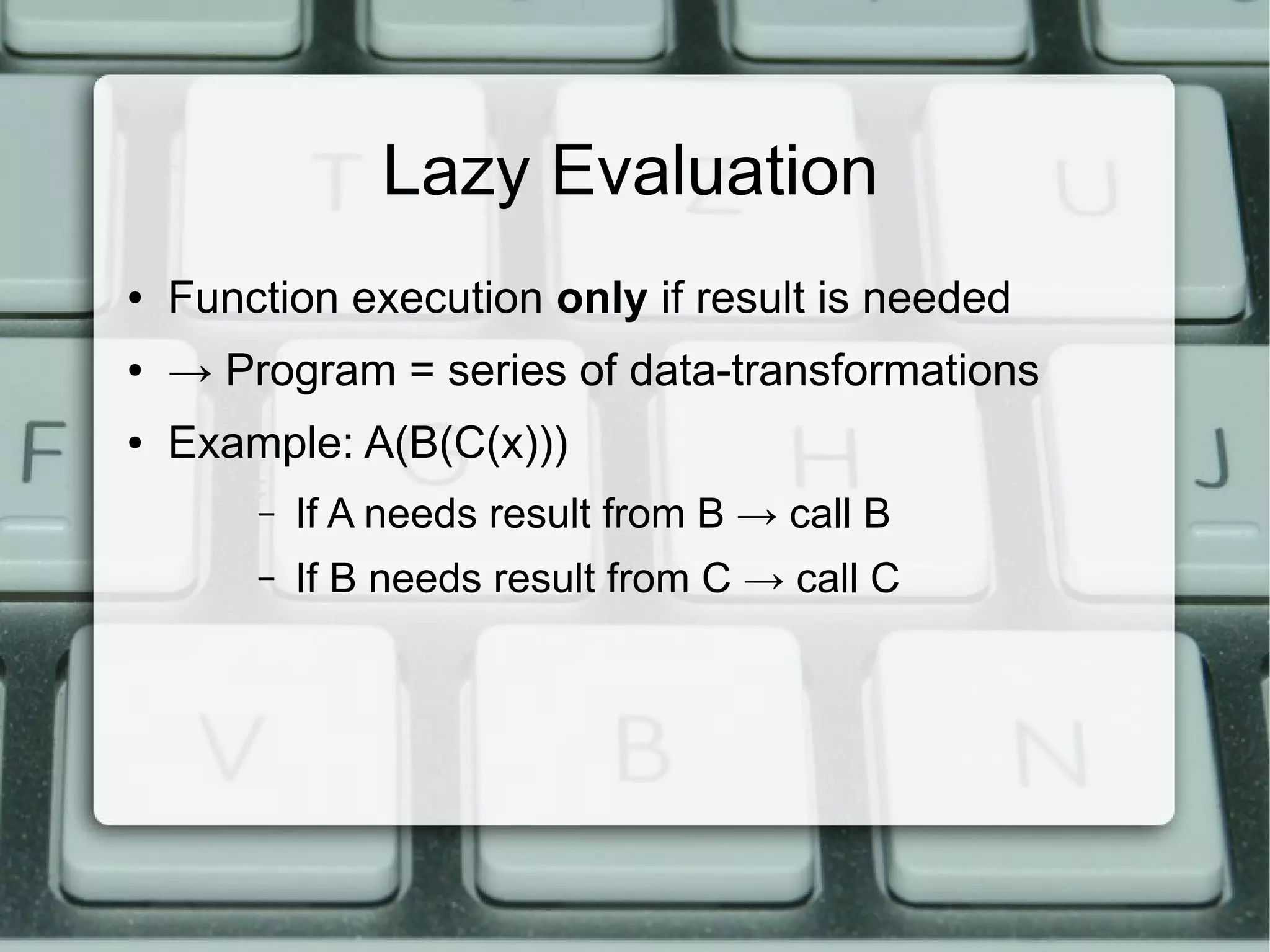
![Pattern Matching (1)
● create matching rules:
fac 0 = 1
fac n = n * fac (n-1)
● use wildcards to ignore parameters in
pattern:
take 0 _ = []
take _ [] = []
take n (x:xs) = [x] ++ take (n-1) xs](https://image.slidesharecdn.com/haskellintro-120315205608-phpapp01/75/01-haskell-introduction-8-2048.jpg)
![Pattern Matching (2)
● use Guards to separate a matching case deeper:
myFilter _ [] = []
myFilter f (x:xs)
| f==x = x:myFilter g xs
| otherwise = myFilter f xs
where g = 2*f
– like an IF THEN ELSE
– Guard Condition evaluate to Bool (True/False)
● eventually define values with where-clause
myFilter 2 [1,2,3,4,5,6] results to [2,4]](https://image.slidesharecdn.com/haskellintro-120315205608-phpapp01/75/01-haskell-introduction-9-2048.jpg)
![List Comprehension (1)
● Example Quicksort:
quicksort [] = []
quicksort (x:xs) =
quicksort [y | y <- xs,y<x] ++ [x] ++ quicksort[y | y <- xs,y>=x]
– Who the f??k needs an array?
● Lists are dynamic, flexible & part of the
language definition = deeply integrated
– List expression (x:xs)
● x is head of list (value),
● xs is tail (list)
● also individual extendable (x:y:ys)
– List Generator: [<value> | <pipe>, <match> ]](https://image.slidesharecdn.com/haskellintro-120315205608-phpapp01/75/01-haskell-introduction-10-2048.jpg)
![List Comprehension (2)
void qsort(int a[], int lo, int hi)
Quicksort in C: ([2])
{
int h, l, p, t;
if (lo < hi) {
l = lo;
h = hi;
p = a[hi];
do {
while ((l < h) && (a[l] <= p))
l = l+1;
while ((h > l) && (a[h] >= p))
h = h-1;
if (l < h) {
t = a[l];
a[l] = a[h];
a[h] = t;
}
} while (l < h);
a[hi] = a[l];
a[l] = p;
qsort( a, lo, l-1 );
qsort( a, l+1, hi );
}
}](https://image.slidesharecdn.com/haskellintro-120315205608-phpapp01/75/01-haskell-introduction-11-2048.jpg)
![List Comprehension (3)
● Example: double entries in list
doubleList [] = []
doubleList (x:xs) = x:x:doubleList xs
● Multiplication of a list of values:
Hugs> product [1..5]
120
● or in a function:
fac n = product [1..n]](https://image.slidesharecdn.com/haskellintro-120315205608-phpapp01/75/01-haskell-introduction-12-2048.jpg)
![Type Polymorphism
● Statically typed, but Compiler can read type from
context (type inference)
● → no need to set type explicitly
● → makes function more generic for different
kinds of types (type polymorphism)
– Why should I use quicksort :: [Int] -> [Int]
– even if I also want to sort character?
Hugs>quicksort ['f','a','d','b']
"abdf"](https://image.slidesharecdn.com/haskellintro-120315205608-phpapp01/75/01-haskell-introduction-13-2048.jpg)
![Recursion (1)
● we have no loops → use Recursion:
myMap :: Int -> [Int] -> [Int]
myMap v [] = [] -- Recursion Anchor!
myMap v (x:xs) = [v*x] ++ myMap v xs
● Recursion Anchor contains the break rule
– endless loop = anchorless recursion
isTrue :: Bool Bool
isTrue b = b && isTrue b](https://image.slidesharecdn.com/haskellintro-120315205608-phpapp01/75/01-haskell-introduction-14-2048.jpg)
![Recursion (2)
● Recursion vs. Final Recursion:
countX :: Int -> [Int] -> Int ● Hugs> countX 3 [1,4,3,5,3]
countX x [] = 0 2
countX x (y:ys)
| x==y = 1 + countX x ys
| otherwise = countX x ys
countXFinal :: Int -> [Int] -> Int -> Int
countXFinal x [] accu = accu
countXFinal x (y:ys) accu
| x==y = countXFinal x ys accu+1
| otherwise = countXFinal x ys accu
● use accumulator to reduce stack usage
● Hugs> countXFinal 3 [1,4,3,5,3] 0
2](https://image.slidesharecdn.com/haskellintro-120315205608-phpapp01/75/01-haskell-introduction-15-2048.jpg)
![History
● Haskell 1.0 (1990) – 1.4
● Haskell 98 (1997)
– quasi standard language definition
– Foreign Function Interface included ([3])
● Haskell Prime (2006 = ~)
– Haskell 2010 (2009)
● first revision
● → now Control Flow Structures available
(Why? I am currently not sure.)](https://image.slidesharecdn.com/haskellintro-120315205608-phpapp01/75/01-haskell-introduction-16-2048.jpg)
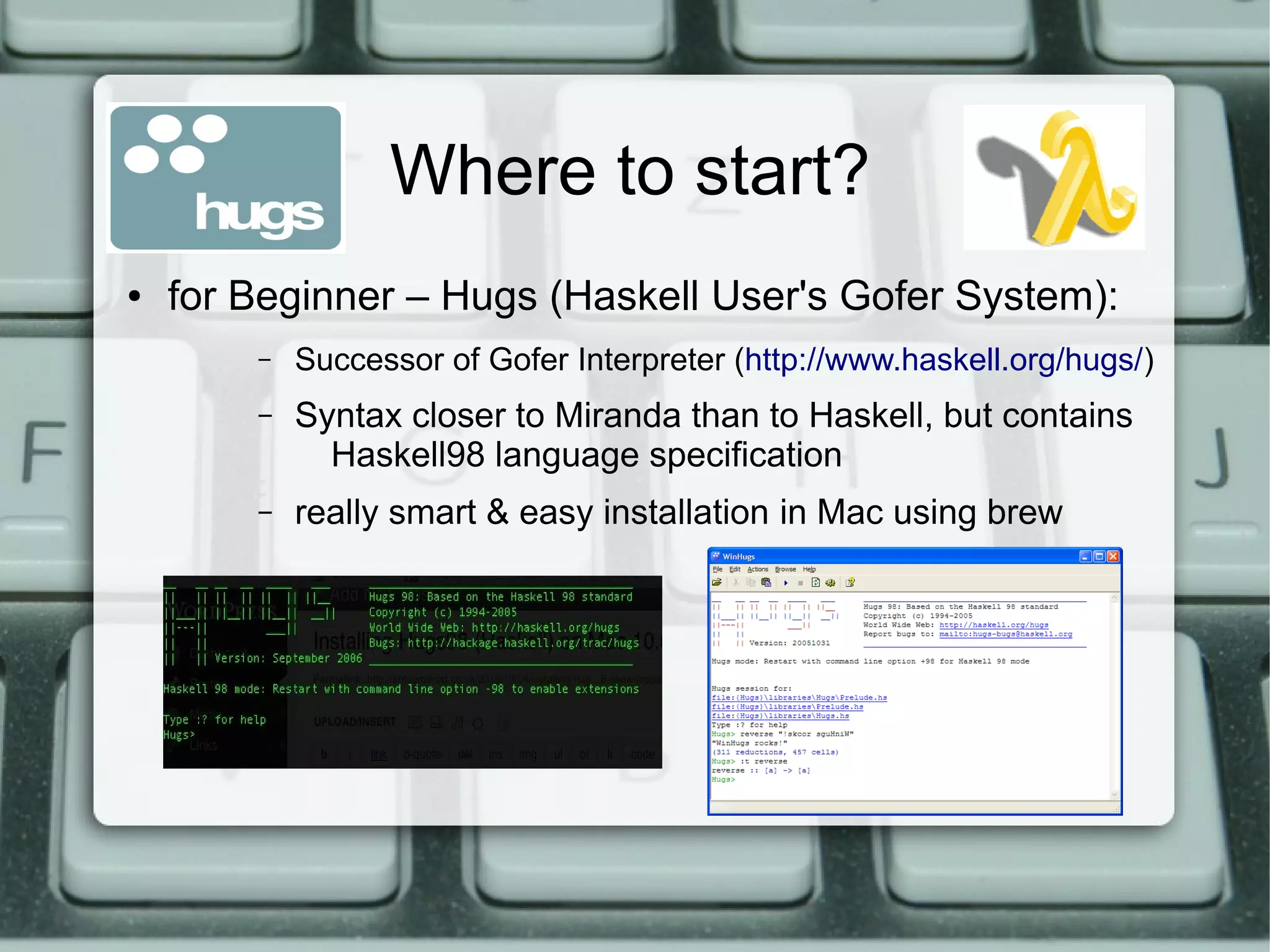
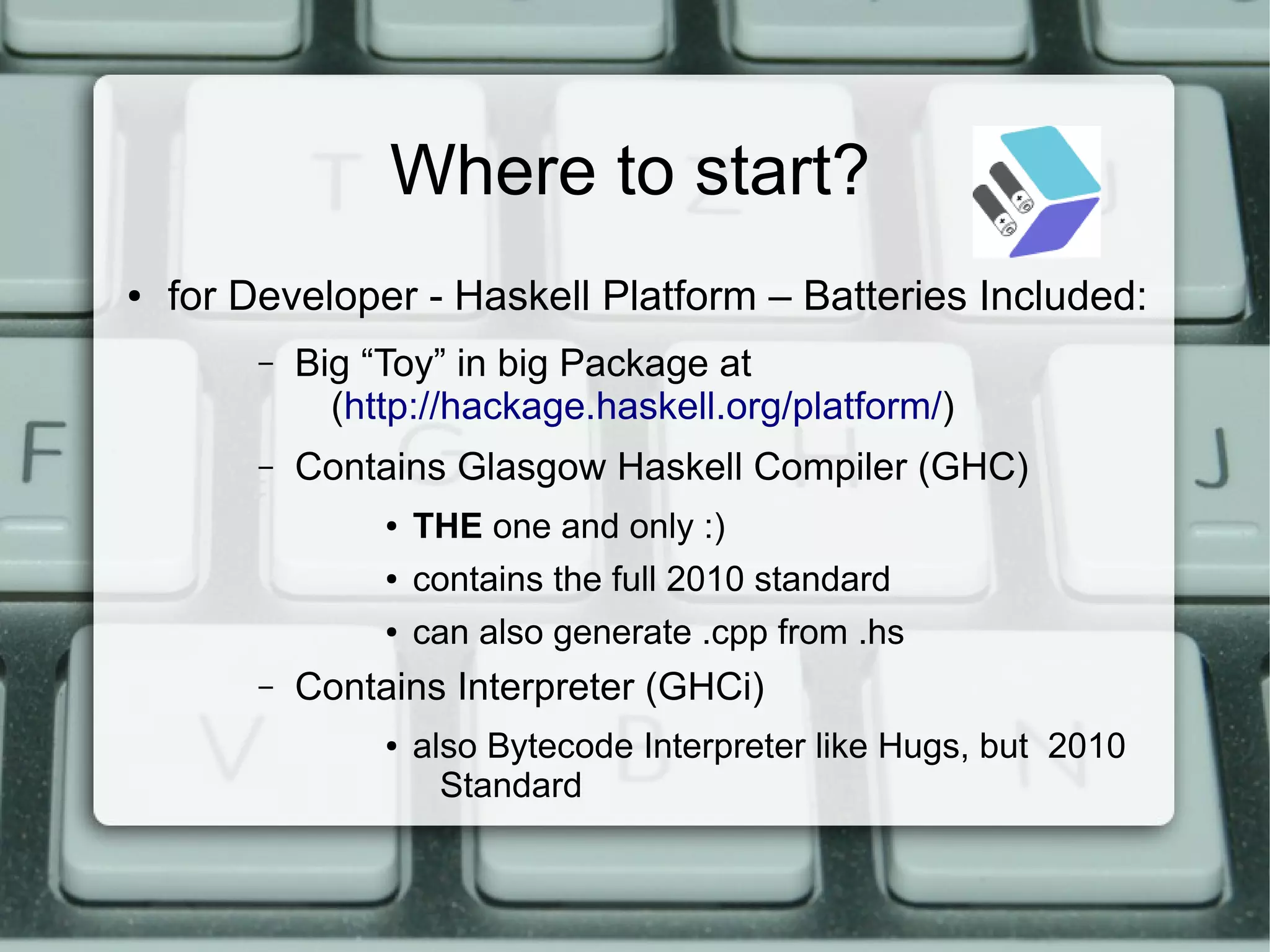
![Sources
[1] Haskell-Tutorial: Learn you a Haskell (http://learnyouahaskell.com/,
2012/03/15)
[2] Haskell Introduction: Quicksort in C (
http://www.haskell.org/haskellwiki/Introduction, 2012/03/15)
[3] The Haskell 98 Foreign Function Interface Addendum (
http://www.cse.unsw.edu.au/~chak/haskell/ffi/, 2012/03/15)](https://image.slidesharecdn.com/haskellintro-120315205608-phpapp01/75/01-haskell-introduction-19-2048.jpg)